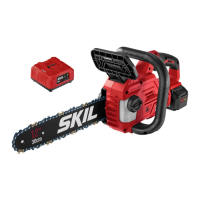31
Top-Plate Sharpening Angles
(Fig. 33)
•
CORRECT 30° – This optimal angle can be
obtained only when the specied les and
proper setting are used. File holders are
marked with guide marks to align the le
properly to produce the correct top plate
angle.
•
LESS THAN 30° – The tooth is too dull for
cutting.
•
MORE THAN 30° – The edge of the cutting
tooth is feathered and dulls quickly.
Side-Plate Angle (Fig. 34)
•
CORRECT 60° – The optimal angle can
be produced automatically if the correct
diameter le is used in the le holder.
•
HOOK – “Grabs” and dulls quickly. Increases
potential of KICKBACK. Results from using a
le with a diameter that is too small, or a le
held too low.
•
BACKWARD SLOPE – Needs too much
feed pressure, causes excessive wear to bar
and chain. Results from using a le with a
diameter too large, or a le held too high.
Fig. 33
Top Plate Sharpening Angles
Less Than
30°
Correct Incorrect Incorrect
More
Than 30°
60°
Fig. 34
Side Plate Angle
Hook
Correct Incorrect Incorrect
Backward
Slope

